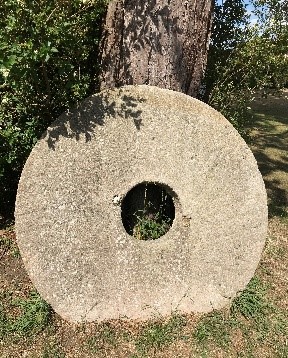THE MILL
Newsletter for Members and Friends of High Salvington Windmill August 2020
Calling for engineering skills
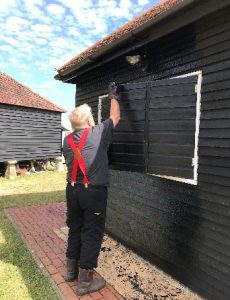 Welcome to a special extra newsletter published by the High Salvington Windmill. As you know, the windmill has been closed all season. But we have taken advantage of this to carry out some essential maintenance work. We were fortunate to receive a Covid-19 business grant from the Government, and the Board decided to spend it to get some jobs done, and also to help the local economy by giving work to local businesses. It was necessary to hire a firm to paint the buck and the sails, while our stalwart band of volunteers will take care of the outbuildings, We thank them for so willingly giving up their time to paint and maintain these buildings. Our Chairman reports later in this newsletter on the measures the Board needs to consider for the long-term future of the windmill. We are specifically looking for a chief engineer with the right skills and experience to maintain the mill in its pristine condition, as well as a coordinator of works.
Welcome to a special extra newsletter published by the High Salvington Windmill. As you know, the windmill has been closed all season. But we have taken advantage of this to carry out some essential maintenance work. We were fortunate to receive a Covid-19 business grant from the Government, and the Board decided to spend it to get some jobs done, and also to help the local economy by giving work to local businesses. It was necessary to hire a firm to paint the buck and the sails, while our stalwart band of volunteers will take care of the outbuildings, We thank them for so willingly giving up their time to paint and maintain these buildings. Our Chairman reports later in this newsletter on the measures the Board needs to consider for the long-term future of the windmill. We are specifically looking for a chief engineer with the right skills and experience to maintain the mill in its pristine condition, as well as a coordinator of works.
Ever since the Windmill Trust was formed, volunteers have willingly given 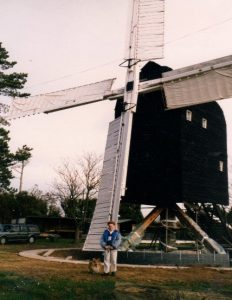 their time. Reader Janet Pelling sent us some pictures of her husband and son, back in the 1980s, helping with the restoration work. On the right you can see son Ian Pelling, aged 11, standing in front of the newly demolished tea-room, before the new roundhouse was built.
their time. Reader Janet Pelling sent us some pictures of her husband and son, back in the 1980s, helping with the restoration work. On the right you can see son Ian Pelling, aged 11, standing in front of the newly demolished tea-room, before the new roundhouse was built.
A look around the mill field
The millstone leaning against the Scots Pine Tree. This millstone was found beneath the patio of a house on the north side of Lowther Road, off Half Moon Lane. The miller in 1792 William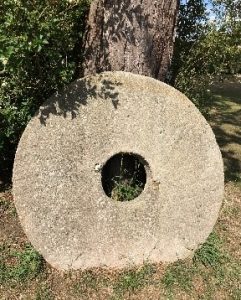 Sheppard also owned Salvington Nurseries just south of Crockhurst Hill and it is possible that he brought the old millstone down the hill – although there are other theories. We think it may have been removed from the mill in the mid-19th century. Although they are very long-lasting, millstones do not last for ever. They are dressed (i.e. the grooves sharpened) regularly but eventually become too thin with the danger of breakage during grinding. The millstone is of Derbyshire Peak stone which produces the rougher, wholemeal flour we produce today on the current stones.
Sheppard also owned Salvington Nurseries just south of Crockhurst Hill and it is possible that he brought the old millstone down the hill – although there are other theories. We think it may have been removed from the mill in the mid-19th century. Although they are very long-lasting, millstones do not last for ever. They are dressed (i.e. the grooves sharpened) regularly but eventually become too thin with the danger of breakage during grinding. The millstone is of Derbyshire Peak stone which produces the rougher, wholemeal flour we produce today on the current stones.
ooOoo
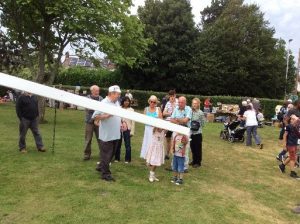 The Tailpole and Talthur. The tailpole is the long white beam behind the mill that gives so much fun to visiting children as they move the mill round. The renovation team got the tailpole to the length it should be (as it had been left too short in the 1960s. They also made and installed the talthur, the lever we use to raise the steps, and so release the mill to turn. The image is of a group of visitors enjoying the thrill of moving the mill. Thirty-three tons of mill can be moved by just a couple of people and children enjoy the thrill of such power.
The Tailpole and Talthur. The tailpole is the long white beam behind the mill that gives so much fun to visiting children as they move the mill round. The renovation team got the tailpole to the length it should be (as it had been left too short in the 1960s. They also made and installed the talthur, the lever we use to raise the steps, and so release the mill to turn. The image is of a group of visitors enjoying the thrill of moving the mill. Thirty-three tons of mill can be moved by just a couple of people and children enjoy the thrill of such power.
Stories taken from “The Mill Field Story” published by the High Salvington Mill Trust 2013, with minor edits.
ooOoo
From field to shelf – from the archive
Grain or corn includes most of the cereals – wheat, barley oats, maize, rye, rice, and buckwheat, to mention a few. These grains (apart from oats, which have to be rolled) can be ground as a part of the milling process to become flour – ‘a finely ground powder prepared from grain or other starchy plant foods’. (continued…)
Where did wheat come from?
The word cereal comes from Ceres, the Roman goddess of agriculture. 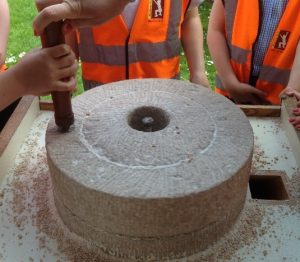 According to myth, it was Ceres who taught humans how to plough, introducing them to grain and the art of grinding. It is believed that grain production began somewhere in or near Mesopotamia and Egypt and could have been growing as early as the 10th century BC. The early grains then crossed with each other to form hybrids, until we eventually ended up with the modern wheat of today.
According to myth, it was Ceres who taught humans how to plough, introducing them to grain and the art of grinding. It is believed that grain production began somewhere in or near Mesopotamia and Egypt and could have been growing as early as the 10th century BC. The early grains then crossed with each other to form hybrids, until we eventually ended up with the modern wheat of today.
The first mills were saddle querns – a flat slab of stone and a hand-held upper stone. Hard work! Next came the quern millstones, similar to the one we have at our mill. On the right you see our own quern being operated by visiting schoolchildren. Querns continued for home use for many centuries but meanwhile, mankind learned to harness animal, wind and water power to turn much larger stones.
Much later, roller milling began – where the grain was ground on rollers rather than millstones. Today’s flour mills are high-tech affairs, but the principle is the same: the grain has to be broken open and refined to produce a usable food product. To make good quality flour, millers must ensure the wheat is good. After a damp summer, wheat grains can begin to sprout before harvest, and the quality of the seed can degrade quickly. When sprouting occurs, enzymes begin to break down the long chains of starch into simple sugars. This impacts the quality of bread and other baked goods made from sprouted wheat.
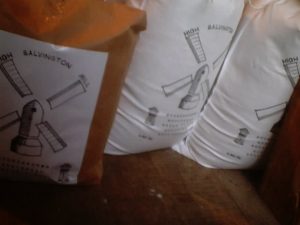 There is a test called the “Hagberg falling number” to measure enzyme activity in flour. It refers to the number of seconds it takes for a plunger to fall through a mix of wheat flour in water. If the plunger falls quickly, it means that the starch has been converted to sugar. However, if the plunger falls slowly, the mixture is thick with starch and thus of good flour. Grain merchants must test their wheat because bakers will only buy flour with a falling number of over 250 (seconds). So millers must ensure that the grain they buy will meet the standard. Ours has to be higher than 250.
There is a test called the “Hagberg falling number” to measure enzyme activity in flour. It refers to the number of seconds it takes for a plunger to fall through a mix of wheat flour in water. If the plunger falls quickly, it means that the starch has been converted to sugar. However, if the plunger falls slowly, the mixture is thick with starch and thus of good flour. Grain merchants must test their wheat because bakers will only buy flour with a falling number of over 250 (seconds). So millers must ensure that the grain they buy will meet the standard. Ours has to be higher than 250.
Information taken from “From Quern to Computer” by the Mills Archive, and thanks to Bob Potts for the Hagberg falling number pointers.
ooOoo
Spicy cheese biscuits
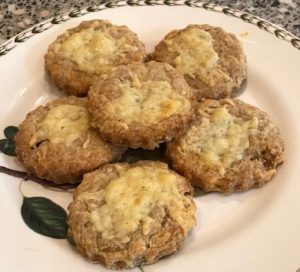 Our flour is produced as souvenir flour. But if you want to bake some souvenir spicy cheese biscuits – here is a recipe. The image is the result of your editor following the instructions. I can report that I put a tad too much cayenne in the mixture for my taste, but they are very cheesy!
Our flour is produced as souvenir flour. But if you want to bake some souvenir spicy cheese biscuits – here is a recipe. The image is the result of your editor following the instructions. I can report that I put a tad too much cayenne in the mixture for my taste, but they are very cheesy!
| 2 oz High Salvington Wholemeal flour
2 oz butter 3 oz cheddar cheese (grated) Pinch of salt and pepper and 2 pinches of Cayenne pepper 1 tablespoon of water Rub the butter thoroughly into the flour, add the dry ingredients and most of the cheese and mix with the water. Roll out the mixture thinly and cut into a variety of fairly small shapes and place on a greased baking tray. Sprinkle the remaining cheese on top. Bake at 190oC (375oF, gas mark 5), for 10-15 minutes. For more recipes purchase our recipe book from the souvenir shop when we open again.
|
The Cootes – a Family of Millers and Bakers of Salvington
In the 19th and early 20th centuries, our miller would have been purchasing his grain from local grain merchant and baker Coote and Sons in Salvington Road. Although started by Alfred Coote, the business was really run by his widow Rhoda and her sons. As a family, they had worked as millers in various mills in Hampshire and Sussex, including ours. They settled in Salvington Road to create their bakery.
ooOoo
In memoriam for Quentin English
Quentin English died on 23rd June, after being diagnosed with cancer just  two weeks earlier. He was a man who loved life, especially making happy memories for others. From artist to art teacher, motorcyclist to Morgan connoisseur, Balkan tour operator to travel lecturer/ examiner/author – and Classic Car Day organiser at the windmill – he did everything he could to make the world more fun for others.
two weeks earlier. He was a man who loved life, especially making happy memories for others. From artist to art teacher, motorcyclist to Morgan connoisseur, Balkan tour operator to travel lecturer/ examiner/author – and Classic Car Day organiser at the windmill – he did everything he could to make the world more fun for others.
He loved telling stories and reminiscing about adventures (or ‘international incidents’ as they were often known!). His cancer was sudden and aggressive and took him quickly. His widow Ann said that she and Quentin have been organising the mill’s Classic Cars open day since 2010 and, via this, have raised substantial funds for the windmill. Ann says she is willing to continue in 2021 – this year’s having been, of course, cancelled. Our condolences go to Ann, and thanks for her continued support for the mill.
ooOoo
Maintenance Co-ordinator
The current Maintenance Co-ordinator, Ian Fairclough will be standing down from this role at the end of the year and the Board would like to hear from anyone who would take this on. The role is to manage the volunteer Maintenance team and liaise with contractors where necessary to arrange working parties to carry out work at the mill which ranges from gardening tasks to heavy engineering. An interest in ensuring the mill continues to be maintained in good working order for the benefit of the local community and our visitors is essential and an engineering background is desirable.
If you would like more information about this role please contact Ian Fairclough on 01903 267354 or 07759 650540.
ooOoo
A word from our Acting Chairman, Jeff Best
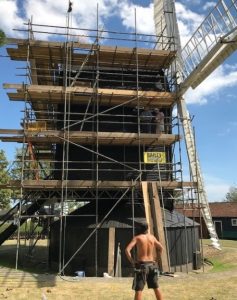
| Scaffolding erected ready for painting work in August |
As I write, we have lost ten open days and events to the pandemic. We have also held a socially distanced AGM with proxy votes and some attendees via Zoom. Work behind the scenes continues. Some of you may have noticed scaffolding going up around the windmill, ready for further repairs to the sails, some cladding replacement and a complete repaint. Less noticeable to passers-by is the completion of the Nutley wind engine with the installation of a pump so we now have two working wind pumps. A few gusty days have pushed the Nutley Wind Generator to produce close to its maximum power output.
Although we had hoped that we might be able to open the mill grounds towards the end of the season, with the currently reported daily averages of new Covid cases and related deaths per day, the Board has reluctantly decided not to open the mill field at all this season. Nor will we be holding the carol service in December. This is a shame, but we simply cannot take any risks with visitors’ and volunteer’s health. As reported elsewhere, the maintenance volunteers remain busy. They are not painting the windmill themselves but have commenced repainting all of the other buildings. The trustees are also active. We need to organise some effective recruitment of both volunteers and members, to fill some specific vacancies and bolster the skills and confidence within the maintenance team. While spending several months on planning is intended to ensure success, if the planned current way in which the mill is managed. Although prudent management by our predecessors has steadily accrued our current reserves they are insufficient to keep the mill maintained for more than a few years if we lack the skills and confidence to do our own maintenance and we have to be aware that our sweeps have already exceeded their expected life. Ideally, we will find a new chief engineer with the skills and experience to take on the management of the maintenance for the foreseeable future.
ooOoo
Membership – get your friends to join us
Without you, our members, we would not be able to continue to run the Mill. Do please pass this newsletter to friends, neighbours or family in case they might like to join as members. Perhaps you even consider buying gift membership for someone.
Our members fall into three categories: Honorary Membership, awarded for long service to the mill; Life Membership, open to all for a one-off fee of £40; Annual Membership: just £4 for a single membership or £7 for a dual membership. A membership application form is included at the end of this newsletter, and please do not hesitate to contact me if you require more information on membership, how to pay by standing order, or how you can support the Trust in any other way.
Annual membership subscriptions can be paid by cheque or by Standing Order, and can be upgraded to Life membership at any time. Members can enter open afternoons free of charge by showing their card at the gate. We currently have 203 members (ten honorary), and would love there to be more.
Any questions: Paul Minter on membership@highsalvingtonwindmilltrust.co.uk
Capt. Paul Minter, Membership
Follow us on Facebook. Just look for High Salvington Windmill and “like” our page to see news about the mill and the planned events throughout the year.
ooOoo
Membership
The cost of an Annual membership is just £4 (£7 for dual membership).The cost of Life membership is £40.
“————————————————————————————————————————-
SUBSCRIPTION TO THE HIGH SALVINGTON MILL TRUST LTD
Annual membership per person £ 4.00 o
per dual couple £ 7.00 o
Life membership per person £40.00 o
I/we enclose CASH/CHEQUE payable to HIGH SALVINGTON MILL TRUST LTD
NAME: ______________________________________________________________________________
ADDRESS: ___________________________________________________________________________
Post Code_________________
Signed _____________________ Date ___________________ email: _____________________________
Send to: Membership secretary, 69 Hayling Rise, High Salvington, Worthing, BN13 3AG
email: membership@highsalvingtonmilltrust.co.uk
Data Protection: If you object to your name and address being kept on computer, please raise the matter with the membership secretary.
Registered in England Company no. 4199780 Registered office: 12 Furzeholme, Worthing BN13 3BS
______________________________________________________________________________________________
‘The Mill’ is edited by Lucy Brooks. 01903 691945
